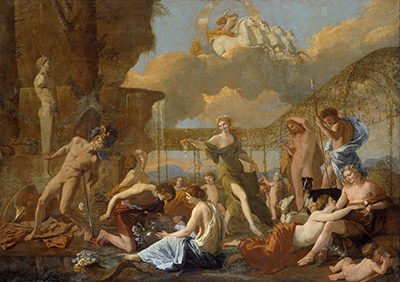The Empire of Flora is a mythical narrative paint on an oil canvas, done in 1631. The style used in the painting is a baroque style. The Empire of Flora painting is set in an open garden, with trees visible in the left background, a flower-laden system of pergolas, a large water vessel and a dancing figure.
The characters are well-known figures. The theme of the paint could be that of a season of the spring or lowers and gardens or metamorphoses. The Empire of Flora depicts the flower goddess, dancing in the middle of the paint and is surrounded by characters which according to metamorphoses turn into flowers upon their deaths. At the far left in the background The Empire of Flora, a herm representing Priapus is seen depicting a god of gardens and fertility. The next figure is that of Ajax falling on his sword. Figures of Narcissus and Echo are also seen and Narcissus is shown enraptured by his own reflection in the water vessel, wasting away in self-love, while Echo stares lovingly at him.
Behind Narcissus is Clytie who is seen glaring longingly at Apollos heavenly sun chariot, clad in yellow and behind her is a large basket of flowers. There is also a figure of Hyacinthus who is seen holding a bunch of hyacinth flowers in his right hand. To the right side of Hyacinthus is Adonis, with two hunting dogs. He is depicted holding a spare, probably his hunting spear on his left hand. The figures of Smilax and Crocus are seen lying on each other in a great atmosphere of love and passion. Finally, a baby is seen resting on a quiver admiring a flower in its hands.
The Empire of Flora is a cheerful picture, thought provoking for its admirer and a calm and relaxed picture. It is a bright picture and colors are in complete harmony. The lighting is from a natural source, the sun, and covers mostly the upper side of the right of the paint. The left side is partially darker. Nicolas Poussin's works are clear, logical and in order. His work and style of painting were profoundly influenced by Giulin Romano engravings and painter Raphael. Over the years, he also influenced a great number of artists including Jacques Stella, Sebastien Burdon, Francesco Mola, Gerard de Lairesse, Eugene Delacroix, Paul Cezanne, Andre Derain, Jean Helion, and Jean Hugo. Other works by Nicolas Poussin are Landscape with Polyphemus, Tancred and Ermina, The Death of Germanicus and the Plague at Ashdod among others.




